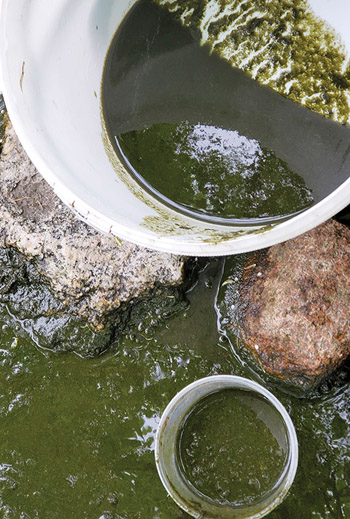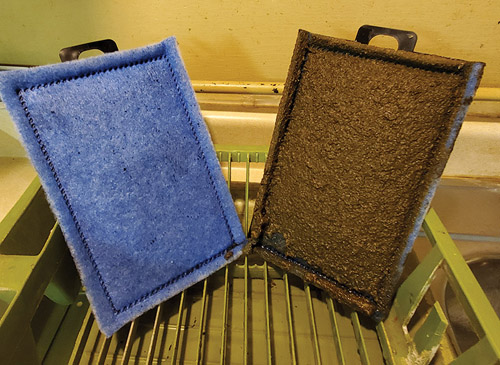
By far, one of the most common challenges that water gardeners collectively face is how to handle sediment — or, should I say, the “muck” that builds up over time in all bodies of water.
But is sediment always bad? It is completely natural for sediment to build up, and most natural pond systems deal with it by incorporating it into their substrate and making it a part of the ecosystem’s health. Critters like bacteria and invertebrates survive by eating various types of particles in the muck, so the substrate becomes an ecosystem in itself.
However, in ponds that are lined with concrete or other material, the sediment is kept separate from the substrate. Because of this, the pond has a limited ability to naturally deal with it. High levels of sediment in lined ponds can have some very serious negative effects.
Sediment can accumulate on a pond bottom and build up in filters, creating an anaerobic (without oxygen) environment that can reach the point of “suffocating” the underwater environment. Toxic gases like hydrogen sulfide build up in accumulated sediment and can kill or harm fish under the right conditions. These gases can also inhibit or kill the aerobic bacteria and invertebrates that an ecosystem needs to be healthy. Sediment can also compromise water quality to the point that it can become suspended in the water column, making the water appear cloudy. Most people, as we know, prefer “gin-clear” water.
What’s in Sediment?
A major component of sediment is under-composed organic matter. This comes from material that was once alive, but died and left its remains on the pond bottom or in its filters. This can include leaves, fish food and even dead critters. The process of decomposition will occur at various rates, depending on the amount of oxygen present, the temperature of the water, and the number of aerobic bacteria and invertebrates that want to eat this stuff. Anaerobic bacteria can also slowly decompose organic matter, producing toxic gases. Adding aerobic bacteria is an easy way to speed up this process, as is making sure that we have good circulation so that the entire water column is well aerated. However, even when organic matter is completely decomposed, there is still some sediment left behind — the undigestible component of organic matter. While it may be a small amount when compared to the organics that originally accumulated, it can still build up.

Another component of sediment is simply soil or dirt comprised of minerals, gases and the undigestible component of organic matter. Minerals do not decompose and will build up over time. Soil can be introduced to the pond in a variety of ways, including from potted plants, from wind-blown dirt and materials, and from the fur and feet of little critters that enter the water. It is amazing how much soil can blow in on a single day!
Removing sediment can be done in many ways. Always remember that it will settle to the bottom of a pond or filter every time, if it’s allowed to. Most ponds with high circulation rates will not allow much settling of the finer particles onto the bottom, causing them to wind up somewhere else — especially in filters.
The most natural place for sediment to accumulate is on the bottom of the pond. Vacuuming the bottom, or performing a complete pond cleanout, is routine — but it’s also a lot of work. It can take a lot of time and require special equipment in some situations. In rock or gravel-bottom ponds, it can take double the amount of time. While the rock or gravel look can be appealing, it comes with a lot of extra work.
One technique I like is using settling chambers. The pond itself may be used as a settling basin, as long as there are bottom drains. Settling chambers are designed so that water is slowed down to allow sediment to naturally settle at the bottom. To clean the sediment out of the pond, a valve is briefly opened to flush out the sediment. Sure, some water is wasted in the process, but the same is true when you’re working with vacuums during pond cleanouts. Bottom drains and settling chambers can add to the initial cost of installation, but in my opinion, they prove well worth it.

There are so many types of filters that can be used to remove sediment. Just a few include phyto (plant) filters, biological filters, UV clarifiers and chemical filters. However, I’ve found mechanical filters to be the most efficient. They work by physically removing sediment from a pond.
Mechanical Filter Media
These include mats, nets, sieves, foam, gravel, rock and other tools that remove sediment. Each style caters to specific sediment particle sizes. It all depends on where the media are located in the chain of water movement. All these methods depend on a pump to move the water through them, and thus will periodically need to be cleaned.
Of course, the smaller the opening in the filter material, the more often it will need to be cleaned. A key objective in any design must be to minimize the cleaning and maintenance requirements for all filter material.

Water pumps need some type of mechanical prefilter, such as a skimmer box, to keep debris and sediment from plugging the impeller intake. Some pumps are designed to serve as more of a “trash pump,” where debris particles as large as ¾-inch can still be pumped without plugging the intake. However, these types of pumps have the tendency to chew up fish, frogs and mulch, so they still need coarse filter material to keep these out. Thankfully, coarse filters generally do not need to be cleaned as often.
Pressurized mechanical filters on the outlet of the pump are mostly intended to polish the water. They can be very efficient at removing even the finest sediment, but they need attention on a regular basis to ensure that they do not become plugged. Even if they do get partially clogged, water pumps can withstand somewhat of a reduction in outlet flow.
Conversely, pumps are not designed to take a reduction in flow on the intake, so prefilters are placed before the pump’s intake to prevent sediment-related flow restriction.
Gravity flow filters are designed to be easy to maintain. They are normally located on the outside of the pond. Water is pumped into the top of them and flows by gravity through the filter media. There are many choices and sizes of mats for these filters. Biological media are usually located after these mats so that the sediment is removed before it completely covers and suffocates the bacteria on the biomedia.
Up-flow filters are engineered for water to be pumped into the bottom of a container, which can vary in size from a 5-gallon bucket to a bog that holds thousands of gallons. The efficiency of these filters is really improved by providing a way of backflushing and a bottom drain to flush out accumulated sediment. Most of these filters also incorporate biological filters that contain media that provide a large surface area to grow bacteria, thereby reducing fish and organic waste to relatively harmless substances. Again, if sediment accumulates in these filters, the biological activity is smothered. This is why backflushing and draining out the sediment on a regular basis is necessary. Examples of up-flow filters include Filter Falls and Bio Falls. Most of these do not have bottom drains and instead have mats preceding the biological media that filter out the sediment. These mats need to be cleaned on a regular basis.All ponds accumulate sediment. Understanding the types of sediment and the use of some great techniques for removing it will greatly improve the health of an ecosystem. The best filters in pond designs are the ones that allow easy removal of the accumulated sediment. Having gin-clear water is a common goal, and efficiently removing sediment will help us all reach that goal. Then, the joy of water gardening begins!



Is there anywhere I can get or see a diagram of your under gravel system with the airlift built into it ? I think I get it , but want to make sure I understand it correctly.
Thanks Brien